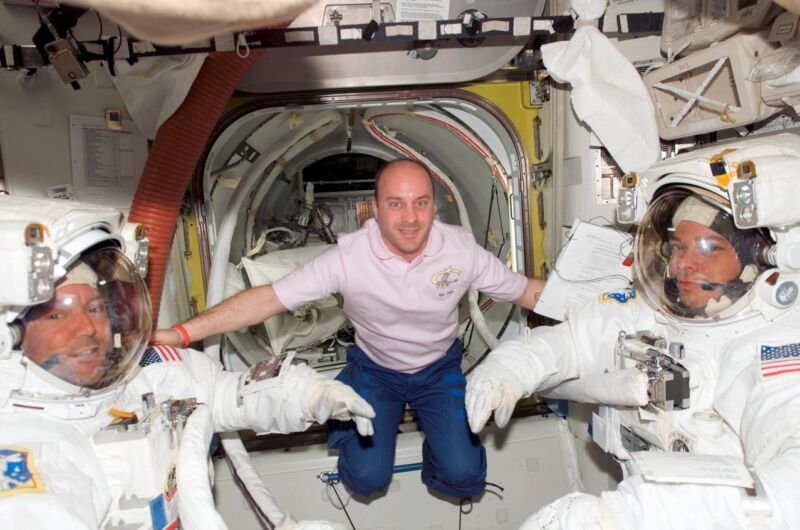
A little more than 15 years ago, astronaut Garrett Reisman was among a crew of seven who launched into orbit aboard Space Shuttle Endeavour. The shuttle remained attached to the Space Station for nearly two weeks, but when the orbiter departed, it left Reisman behind for an extended stay.
During his time at the station, Reisman would often pass through the Harmony module, which serves as a corridor connecting laboratory modules built by NASA and the European and Japanese space agencies. Sometimes, he would look up and see a small placard that said, "To CAM." The arrow, however, pointed out into space.
"When I was up there on the space station, there was still the sign that says, 'To CAM,'" Reisman said in an interview. "But there's just a closed hatch. It was tragic. It was just kind of taunting me when I saw that because I think that could have been one of the most important scientific discoveries that we made."
The "CAM" was the Centrifuge Accommodation Module, originally built by the Japanese space agency. It was intended to provide an environment for artificial gravity experiments, from just slightly above zero gravity all the way to 2 gs. However, NASA canceled the final development and launch of the centrifuge module in 2005 due to budgetary concerns.
A big loss
For Reisman, who flew a second shuttle mission on Atlantis in 2010 to help complete construction of the station, this was a major concern. As a veteran of long-duration spaceflights, he has witnessed firsthand the toll that microgravity took on his body and the bodies of his fellow astronauts.
For example, based on data from hundreds of astronauts who have lived on the International Space Station, NASA has found that weight-bearing bones lose on average 1 to 1.5 percent of mineral density per month during spaceflight, and after returning to Earth, this bone loss is not completely corrected by rehabilitation. Moreover, without the proper diet and exercise routine, astronauts also lose muscle mass in space.
Additionally, after just a few weeks in space, some astronauts also lose sharpness in their vision due to swelling of their optic nerves. One study by NASA about a decade ago found that about 30 percent of space shuttle astronauts had a decline in the clarity of their vision, as did 60 percent of space station residents.
Reisman also noted the concerning case of a blood clot of a NASA astronaut in 2018 when the blood in their jugular vein appeared to reverse its flow. This led to venous thrombosis and a life-threatening condition, increasing NASA's concerns about the implications for long-duration travel to Mars.
"It is possible that, with even just a small application of gravity, we'll be able to solve some of these problems," Reisman said. "But we don't know. Artificial gravity space stations are a way to figure out what happens in between."
A Vast solution
In 2011, Reisman left NASA to work for SpaceX. There, for the next seven years, he helped the company with the development and testing of the Crew Dragon spacecraft. Dragon has become NASA's sole means of launching its astronauts to and from the International Space Station. And as NASA considers a future populated by commercial space stations in low-Earth orbit, Dragon is expected to remain a critical part of the transportation infrastructure.
One of those commercial station companies is Vast Space, which plans to launch its Haven-1 space station as early as 2025. Vast has partnered with SpaceX to launch Haven-1 on a Falcon 9 rocket and to send crew there on board Dragon. The company also plans to leverage Dragon's life support systems while astronauts are on board Haven-1.
The long-term plans for Vast include a series of larger space stations that will feature artificial gravity, and this prompted Reisman to join the company as a "human spaceflight advisor" earlier this month. Reisman will bring both his human spaceflight experience and deep knowledge of the Dragon spacecraft to Vast. But what most intrigues him is the potential to finally begin studying how artificial gravity could sustain long-term human spaceflight.
"It's extremely important," Reisman said. "From a scientific perspective, we have lots of data at one g, where we have billions of data points of how the human body works in this environment. And we have a decent amount of data points at zero g based largely from the ISS experience. But we have nothing in between one and zero." The lunar landings during the Apollo program were short enough to essentially provide no meaningful data.
Vast, he said, is the first credible organization to be working on a path toward artificial gravity space stations. This will help answer critical questions such as whether human health problems experienced by astronauts are linear or exponential in nature. For example, the application of just a bit of gravity may ameliorate many of these problems.
There would also be other benefits to having a modest amount of gravity, he said. "It would be nice, sometimes, to be able to pour yourself a cup of coffee," Reisman said.
reader comments
178 with